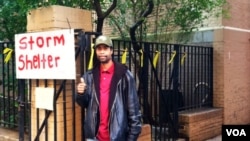NEW YORK —
With limited subway and bus service restored, the hardship caused by flooding and power outages in New York City has begun to ease since Monday night, when Hurricane Sandy struck the U.S. East Coast. But for thousands of residents from low-lying areas in New York who were evacuated to temporary shelters, the dislocation and struggle continue.
Outside a Manhattan public high school, whose gymnasium has been turned into a shelter for up to 100 displaced storm victims, Jesus Flores says he is grateful to shelter workers, volunteers and the city.
“They give me very good help. They give me [a] bed. They give me a blanket. They give me food, everything. And I feel comfortable because I have a place to stay, and I can make it. It’s a good thing,” Flores said.
Like Flores, a Lower East Side resident named Jeffrey is grateful for the shelter, but says life there is hard.
“It’s uncomfortable for me. I can’t sleep well. I can’t go into the refrigerator like I do. I can’t cook my own food. I have to be supplied food. And we don’t know how long we’re gonna stay here either. It’s bad,” Jeffrey said.
Linda Hilton is haunted by memories of Monday afternoon, when she was ordered to evacuate her apartment in advance of Hurricane Sandy.
“So I just packed up my necessary things like meds, myself, my coat and just rushed out of the house and I got on the bus. And the storm came, and lights were all dark and it was raining, and they told me down in my area is flooded. I’m still waiting for them to put on the light. Once they fix everything, I’ll be safe and happy to go home,” Hilton said.
One man, Felix, was part of a longstanding homeless camp downtown that was dispersed by police hours before the storm.
“So some people we have not seen since Sunday, and it’s kind of nerve-wracking,” Felix said.
Life inside the shelter can be nerve-wracking, says a city shelter staff member who requested anonymity because he is forbidden to speak with the press.
“When you have people living in cramped spaces for any length of time, there are going to be tensions. We have families on one side and on the other we have the street population, the homeless. We have a big problem with certain individuals, I would say [the] street population, and they have substance abuse problems and they’ve been very problematic to say the least,” Shelter said.
The shelter has been inundated with volunteers, and food and clothing donations from neighborhood well-wishers like Rebecca Garfein-Gellman.
“You feel a little helpless in a situation we’ve just had in our city. And to be able to do something for someone else, it makes me feel a little better. My heart is very broken right now,” Grafein-Fellman said.
Officials are not sure whether this shelter and others like it will remain open once the schools in which they are housed reopen.
Outside a Manhattan public high school, whose gymnasium has been turned into a shelter for up to 100 displaced storm victims, Jesus Flores says he is grateful to shelter workers, volunteers and the city.
“They give me very good help. They give me [a] bed. They give me a blanket. They give me food, everything. And I feel comfortable because I have a place to stay, and I can make it. It’s a good thing,” Flores said.
Like Flores, a Lower East Side resident named Jeffrey is grateful for the shelter, but says life there is hard.
“It’s uncomfortable for me. I can’t sleep well. I can’t go into the refrigerator like I do. I can’t cook my own food. I have to be supplied food. And we don’t know how long we’re gonna stay here either. It’s bad,” Jeffrey said.
Linda Hilton is haunted by memories of Monday afternoon, when she was ordered to evacuate her apartment in advance of Hurricane Sandy.
“So I just packed up my necessary things like meds, myself, my coat and just rushed out of the house and I got on the bus. And the storm came, and lights were all dark and it was raining, and they told me down in my area is flooded. I’m still waiting for them to put on the light. Once they fix everything, I’ll be safe and happy to go home,” Hilton said.
One man, Felix, was part of a longstanding homeless camp downtown that was dispersed by police hours before the storm.
“So some people we have not seen since Sunday, and it’s kind of nerve-wracking,” Felix said.
Life inside the shelter can be nerve-wracking, says a city shelter staff member who requested anonymity because he is forbidden to speak with the press.
“When you have people living in cramped spaces for any length of time, there are going to be tensions. We have families on one side and on the other we have the street population, the homeless. We have a big problem with certain individuals, I would say [the] street population, and they have substance abuse problems and they’ve been very problematic to say the least,” Shelter said.
The shelter has been inundated with volunteers, and food and clothing donations from neighborhood well-wishers like Rebecca Garfein-Gellman.
“You feel a little helpless in a situation we’ve just had in our city. And to be able to do something for someone else, it makes me feel a little better. My heart is very broken right now,” Grafein-Fellman said.
Officials are not sure whether this shelter and others like it will remain open once the schools in which they are housed reopen.






